Wolf
| Wolf | |
|---|---|
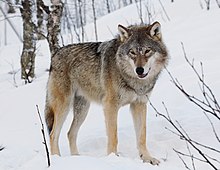
| |
Eurasian wolf (Canis lupus lupus) at Polar Park in Bardu, Norway
| |
| Scientific classification | |
| Domain: | Eukaryota |
| Kingdom: | Animalia |
| Phylum: | Chordata |
| Class: | Mammalia |
| Order: | Carnivora |
| Family: | Canidae |
| Genus: | Canis |
| Species: | C. lupus
|
| Binomial name | |
| Canis lupus | |
| Subspecies | |

| |
| Global wolf range based on IUCN's 2018 assessment.[2] | |
The wolf (Canis lupus;[b] pl.: wolves), also known as the gray wolf or grey wolf, is a large canine native to Eurasia and North America. More than thirty subspecies of Canis lupus have been recognized, including the dog and dingo, though gray wolves, as popularly understood, only comprise naturally-occurring wild subspecies. The wolf is the largest extant member of the family Canidae, and is further distinguished from other Canis species by its less pointed ears and muzzle, as well as a shorter torso and a longer tail. The wolf is nonetheless related closely enough to smaller Canis species, such as the coyote and the golden jackal, to produce fertile hybrids with them. The wolf's fur is usually mottled white, brown, gray, and black, although subspecies in the arctic region may be nearly all white.
Of all members of the
The global wild wolf population was estimated to be 300,000 in 2003 and is considered to be of Least Concern by the International Union for Conservation of Nature (IUCN). Wolves have a long history of interactions with humans, having been despised and hunted in most pastoral communities because of their attacks on livestock, while conversely being respected in some agrarian and hunter-gatherer societies. Although the fear of wolves exists in many human societies, the majority of recorded attacks on people have been attributed to animals suffering from rabies. Wolf attacks on humans are rare because wolves are relatively few, live away from people, and have developed a fear of humans because of their experiences with hunters, farmers, ranchers, and shepherds.
Etymology
The English "wolf" stems from the Old English wulf, which is itself thought to be derived from the Proto-Germanic *wulfaz. The Proto-Indo-European root *wĺ̥kʷos may also be the source of the Latin word for the animal lupus (*lúkʷos).[5][6] The name "gray wolf" refers to the grayish colour of the species.[7]
Since pre-Christian times,
Taxonomy
| Canine phylogeny with ages of divergence | |||||||||||||||||||||||||||||||||||||||||||||
| |||||||||||||||||||||||||||||||||||||||||||||
| Cladogram and divergence of the gray wolf (including the domestic dog) among its closest extant relatives[9] |
In 1758, the Swedish botanist and zoologist
Subspecies
In the third edition of
Evolution
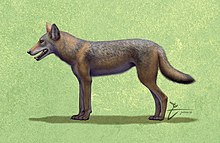
The
Genomic studies suggest modern wolves and dogs descend from a common ancestral wolf population[17][18][19] that existed 20,000 years ago.[17] A 2021 study found that the Himalayan wolf and the Indian plains wolf are part of a lineage that is basal to other wolves and split from them 200,000 years ago.[20] Other wolves appear to have originated in Beringia in an expansion that was driven by the huge ecological changes during the close of the Late Pleistocene.[21] A study in 2016 indicates that a population bottleneck was followed by a rapid radiation from an ancestral population at a time during, or just after, the Last Glacial Maximum. This implies the original morphologically diverse wolf populations were out-competed and replaced by more modern wolves.[22]
A 2016 genomic study suggests that Old World and New World wolves split around 12,500 years ago followed by the
Admixture with other canids

In the distant past, there was gene flow between African wolves, golden jackals, and gray wolves. The African wolf is a descendant of a genetically admixed canid of 72% wolf and 28% Ethiopian wolf ancestry. One African wolf from the Egyptian Sinai Peninsula showed admixture with Middle Eastern gray wolves and dogs.[24] There is evidence of gene flow between golden jackals and Middle Eastern wolves, less so with European and Asian wolves, and least with North American wolves. This indicates the golden jackal ancestry found in North American wolves may have occurred before the divergence of the Eurasian and North American wolves.[25]
The common ancestor of the coyote and the wolf admixed with a
In more recent times, some male
Description
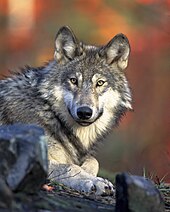
The wolf is the largest extant member of the Canidae family,[31] and is further distinguished from coyotes and jackals by a broader snout, shorter ears, a shorter torso and a longer tail.[32][31] It is slender and powerfully built, with a large, deeply descending rib cage, a sloping back, and a heavily muscled neck.[33] The wolf's legs are moderately longer than those of other canids, which enables the animal to move swiftly, and to overcome the deep snow that covers most of its geographical range in winter.[34] The ears are relatively small and triangular.[33] The wolf's head is large and heavy, with a wide forehead, strong jaws and a long, blunt muzzle.[35] The skull is 230–280 mm (9–11 in) in length and 130–150 mm (5–6 in) in width.[36] The teeth are heavy and large, making them better suited to crushing bone than those of other canids, though they are not as specialized as those found in hyenas.[37][38] Its molars have a flat chewing surface, but not to the same extent as the coyote, whose diet contains more vegetable matter.[39] Females tend to have narrower muzzles and foreheads, thinner necks, slightly shorter legs, and less massive shoulders than males.[40]
Adult wolves measure 105–160 cm (41–63 in) in length and 80–85 cm (31–33 in) at shoulder height.[35] The tail measures 29–50 cm (11–20 in) in length, the ears 90–110 mm (3+1⁄2–4+3⁄8 in) in height, and the hind feet are 220–250 mm (8+5⁄8–9+7⁄8 in).[41] The size and weight of the modern wolf increases proportionally with latitude in accordance with Bergmann's rule.[42] The mean body mass of the wolf is 40 kg (88 lb), the smallest specimen recorded at 12 kg (26 lb) and the largest at 79.4 kg (175 lb).[43][35] On average, European wolves weigh 38.5 kg (85 lb), North American wolves 36 kg (79 lb), and Indian and Arabian wolves 25 kg (55 lb).[44] Females in any given wolf population typically weigh 2.3–4.5 kg (5–10 lb) less than males. Wolves weighing over 54 kg (119 lb) are uncommon, though exceptionally large individuals have been recorded in Alaska and Canada.[45] In central Russia, exceptionally large males can reach a weight of 69–79 kg (152–174 lb).[41]
Pelage
The wolf has very dense and fluffy winter fur, with a short
In cold climates, the wolf can reduce the flow of blood near its skin to conserve body heat. The warmth of the foot pads is regulated independently from the rest of the body and is maintained at just above tissue-freezing point where the pads come in contact with ice and snow.[46] In warm climates, the fur is coarser and scarcer than in northern wolves.[35] Female wolves tend to have smoother furred limbs than males and generally develop the smoothest overall coats as they age. Older wolves generally have more white hairs on the tip of the tail, along the nose, and on the forehead. Winter fur is retained longest by lactating females, although with some hair loss around their teats.[40] Hair length on the middle of the back is 60–70 mm (2+3⁄8–2+3⁄4 in), and the guard hairs on the shoulders generally do not exceed 90 mm (3+1⁄2 in), but can reach 110–130 mm (4+3⁄8–5+1⁄8 in).[35]
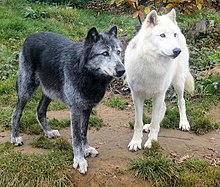
A wolf's coat colour is determined by its guard hairs. Wolves usually have some hairs that are white, brown, gray and black.[47] The coat of the Eurasian wolf is a mixture of ochreous (yellow to orange) and rusty ochreous (orange/red/brown) colours with light gray. The muzzle is pale ochreous gray, and the area of the lips, cheeks, chin, and throat is white. The top of the head, forehead, under and between the eyes, and between the eyes and ears is gray with a reddish film. The neck is ochreous. Long, black tips on the hairs along the back form a broad stripe, with black hair tips on the shoulders, upper chest and rear of the body. The sides of the body, tail, and outer limbs are a pale dirty ochreous colour, while the inner sides of the limbs, belly, and groin are white. Apart from those wolves which are pure white or black, these tones vary little across geographical areas, although the patterns of these colours vary between individuals.[48]
In North America, the coat colours of wolves follow Gloger's rule, wolves in the Canadian arctic being white and those in southern Canada, the U.S., and Mexico being predominantly gray. In some areas of the Rocky Mountains of Alberta and British Columbia, the coat colour is predominantly black, some being blue-gray and some with silver and black.[47] Differences in coat colour between sexes is absent in Eurasia;[49] females tend to have redder tones in North America.[50] Black-coloured wolves in North America acquired their colour from wolf-dog admixture after the first arrival of dogs across the Bering Strait 12,000 to 14,000 years ago.[51] Research into the inheritance of white colour from dogs into wolves has yet to be undertaken.[52]
Ecology
Distribution and habitat
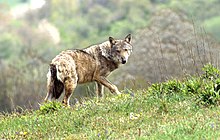
Wolves occur across Eurasia and North America. However, deliberate human persecution because of livestock predation and fear of attacks on humans has reduced the wolf's range to about one-third of its historic range; the wolf is now
Diet
Like all land mammals that are
In North America, the wolf's diet is dominated by wild large hoofed mammals (ungulates) and medium-sized mammals. In Asia and Europe, their diet is dominated by wild medium-sized hoofed mammals and domestic species. The wolf depends on wild species, and if these are not readily available, as in Asia, the wolf is more reliant on domestic species.[56] Across Eurasia, wolves prey mostly on moose, red deer, roe deer and wild boar.[57] In North America, important range-wide prey are elk, moose, caribou, white-tailed deer and mule deer.[58] Wolves can digest their meal in a few hours and can feed several times in one day, making quick use of large quantities of meat.[59] A well-fed wolf stores fat under the skin, around the heart, intestines, kidneys, and bone marrow, particularly during the autumn and winter.[60]
Nonetheless, wolves are not fussy eaters. Smaller-sized animals that may supplement their diet include
In times of scarcity, wolves will readily eat carrion.[61] In Eurasian areas with dense human activity, many wolf populations are forced to subsist largely on livestock and garbage.[57] As prey in North America continue to occupy suitable habitats with low human density, North American wolves eat livestock and garbage only in dire circumstances.[66] Cannibalism is not uncommon in wolves during harsh winters, when packs often attack weak or injured wolves and may eat the bodies of dead pack members.[61][67][68]
Interactions with other predators
Wolves typically dominate other canid species in areas where they both occur. In North America, incidents of wolves killing coyotes are common, particularly in winter, when coyotes feed on wolf kills. Wolves may attack coyote den sites, digging out and killing their pups, though rarely eating them. There are no records of coyotes killing wolves, though coyotes may chase wolves if they outnumber them.[69] According to a press release by the U.S. Department of Agriculture in 1921, the infamous Custer Wolf relied on coyotes to accompany him and warn him of danger. Though they fed from his kills, he never allowed them to approach him.[70] Interactions have been observed in Eurasia between wolves and golden jackals, the latter's numbers being comparatively small in areas with high wolf densities.[35][69][71] Wolves also kill red, Arctic and corsac foxes, usually in disputes over carcasses, sometimes eating them.[35][72]
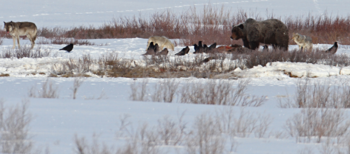
Brown bears typically dominate wolf packs in disputes over carcasses, while wolf packs mostly prevail against bears when defending their den sites. Both species kill each other's young. Wolves eat the brown bears they kill, while brown bears seem to eat only young wolves.[73] Wolf interactions with American black bears are much rarer because of differences in habitat preferences. Wolves have been recorded on numerous occasions actively seeking out American black bears in their dens and killing them without eating them. Unlike brown bears, American black bears frequently lose against wolves in disputes over kills.[74] Wolves also dominate and sometimes kill wolverines, and will chase off those that attempt to scavenge from their kills. Wolverines escape from wolves in caves or up trees.[75]
Wolves may interact and compete with
In Israel, Palestine, Central Asia and India wolves may encounter striped hyenas, usually in disputes over carcasses. Striped hyenas feed extensively on wolf-killed carcasses in areas where the two species interact. One-to-one, hyenas dominate wolves, and may prey on them,[82] but wolf packs can drive off single or outnumbered hyenas.[83][84] There is at least one case in Israel of a hyena associating and cooperating with a wolf pack.[85]
Infections

Wolves are often infested with a variety of
Behaviour
Social structure

The wolf is a
Offspring typically stay in the pack for 10–54 months before dispersing.[93] Triggers for dispersal include the onset of sexual maturity and competition within the pack for food.[94] The distance travelled by dispersing wolves varies widely; some stay in the vicinity of the parental group, while other individuals may travel great distances of upwards of 206 km (128 mi), 390 km (240 mi), and 670 km (420 mi) from their natal (birth) packs.[95] A new pack is usually founded by an unrelated dispersing male and female, travelling together in search of an area devoid of other hostile packs.[96] Wolf packs rarely adopt other wolves into their fold and typically kill them. In the rare cases where other wolves are adopted, the adoptee is almost invariably an immature animal of one to three years old, and unlikely to compete for breeding rights with the mated pair. This usually occurs between the months of February and May. Adoptee males may mate with an available pack female and then form their own pack. In some cases, a lone wolf is adopted into a pack to replace a deceased breeder.[91]
Wolves are territorial and generally establish territories far larger than they require to survive assuring a steady supply of prey. Territory size depends largely on the amount of prey available and the age of the pack's pups. They tend to increase in size in areas with low prey populations,[97] or when the pups reach the age of six months when they have the same nutritional needs as adults.[98] Wolf packs travel constantly in search of prey, covering roughly 9% of their territory per day, on average 25 km/d (16 mi/d). The core of their territory is on average 35 km2 (14 sq mi) where they spend 50% of their time.[97] Prey density tends to be much higher on the territory's periphery. Wolves tend to avoid hunting on the fringes of their range to avoid fatal confrontations with neighbouring packs.[99] The smallest territory on record was held by a pack of six wolves in northeastern Minnesota, which occupied an estimated 33 km2 (13 sq mi), while the largest was held by an Alaskan pack of ten wolves encompassing 6,272 km2 (2,422 sq mi).[98] Wolf packs are typically settled, and usually leave their accustomed ranges only during severe food shortages.[35] Territorial fights are among the principal causes of wolf mortality, one study concluding that 14–65% of wolf deaths in Minnesota and the Denali National Park and Preserve were due to other wolves.[100]
Communication
Wolves communicate using vocalizations, body postures, scent, touch, and taste.[101] The phases of the moon have no effect on wolf vocalization, and despite popular belief, wolves do not howl at the Moon.[102] Wolves howl to assemble the pack usually before and after hunts, to pass on an alarm particularly at a den site, to locate each other during a storm, while crossing unfamiliar territory, and to communicate across great distances.[103] Wolf howls can under certain conditions be heard over areas of up to 130 km2 (50 sq mi).[39] Other vocalizations include growls, barks and whines. Wolves do not bark as loudly or continuously as dogs do in confrontations, rather barking a few times and then retreating from a perceived danger.[104] Aggressive or self-assertive wolves are characterized by their slow and deliberate movements, high body posture and raised hackles, while submissive ones carry their bodies low, flatten their fur, and lower their ears and tail.[105]
Scent marking involves urine, feces, and anal gland scents. This is more effective at advertising territory than howling and is often used in combination with scratch marks. Wolves increase their rate of scent marking when they encounter the marks of wolves from other packs. Lone wolves will rarely mark, but newly bonded pairs will scent mark the most.[39] These marks are generally left every 240 m (260 yd) throughout the territory on regular travelways and junctions. Such markers can last for two to three weeks,[98] and are typically placed near rocks, boulders, trees, or the skeletons of large animals.[35] Raised leg urination is considered to be one of the most important forms of scent communication in the wolf, making up 60–80% of all scent marks observed.[106]
Reproduction

Wolves are
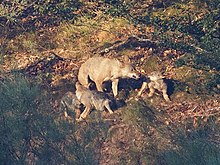
Dens are usually constructed for pups during the summer period. When building dens, females make use of natural shelters like fissures in rocks, cliffs overhanging riverbanks and holes thickly covered by vegetation. Sometimes, the den is the appropriated burrow of smaller animals such as foxes, badgers or marmots. An appropriated den is often widened and partly remade. On rare occasions, female wolves dig burrows themselves, which are usually small and short with one to three openings. The den is usually constructed not more than 500 m (550 yd) away from a water source. It typically faces southwards where it can be better warmed by sunlight exposure, and the snow can thaw more quickly. Resting places, play areas for the pups, and food remains are commonly found around wolf dens. The odor of urine and rotting food emanating from the denning area often attracts scavenging birds like
The
Hunting and feeding

Single wolves or mated pairs typically have higher success rates in hunting than do large packs; single wolves have occasionally been observed to kill large prey such as moose, bison and muskoxen unaided.[116][117] The size of a wolf hunting pack is related to the number of pups that survived the previous winter, adult survival, and the rate of dispersing wolves leaving the pack. The optimal pack size for hunting elk is four wolves, and for bison a large pack size is more successful.[118] Wolves move around their territory when hunting, using the same trails for extended periods.[119] Wolves are nocturnal predators. During the winter, a pack will commence hunting in the twilight of early evening and will hunt all night, traveling tens of kilometres. Sometimes hunting large prey occurs during the day. During the summer, wolves generally tend to hunt individually, ambushing their prey and rarely giving pursuit.[120]
When hunting large gregarious prey, wolves will try to isolate an individual from its group.[121] If successful, a wolf pack can bring down game that will feed it for days, but one error in judgement can lead to serious injury or death. Most large prey have developed defensive adaptations and behaviours. Wolves have been killed while attempting to bring down bison, elk, moose, muskoxen, and even by one of their smallest hoofed prey, the white-tailed deer. With smaller prey like beaver, geese, and hares, there is no risk to the wolf.[122] Although people often believe wolves can easily overcome any of their prey, their success rate in hunting hoofed prey is usually low.[123]

The wolf must give chase and gain on its fleeing prey, slow it down by biting through thick hair and hide, and then disable it enough to begin feeding.[122] Wolves may wound large prey and then lie around resting for hours before killing it when it is weaker due to blood loss, thereby lessening the risk of injury to themselves.[124] With medium-sized prey, such as roe deer or sheep, wolves kill by biting the throat, severing nerve tracks and the carotid artery, thus causing the animal to die within a few seconds to a minute. With small, mouselike prey, wolves leap in a high arc and immobilize it with their forepaws.[125]
Once prey is brought down, wolves begin to feed excitedly, ripping and tugging at the carcass in all directions, and bolting down large chunks of it.[126] The breeding pair typically monopolizes food to continue producing pups. When food is scarce, this is done at the expense of other family members, especially non-pups.[127] Wolves typically commence feeding by gorging on the larger internal organs, like the heart, liver, lungs, and stomach lining. The kidneys and spleen are eaten once they are exposed, followed by the muscles.[128] A wolf can eat 15–19% of its body weight in one sitting.[60]
Status and conservation
The global wild wolf population in 2003 was estimated at 300,000.
North America

In Canada, 50,000–60,000 wolves live in 80% of their historical range, making Canada an important stronghold for the species.[39] Under Canadian law, First Nations people can hunt wolves without restrictions, but others must acquire licenses for the hunting and trapping seasons. As many as 4,000 wolves may be harvested in Canada each year.[130] The wolf is a protected species in national parks under the Canada National Parks Act.[131] In Alaska, 7,000–11,000 wolves are found on 85% of the state's 1,517,733 km2 (586,000 sq mi) area. Wolves may be hunted or trapped with a license; around 1,200 wolves are harvested annually.[132]
In the
Eurasia

Europe, excluding Russia, Belarus and Ukraine, has 17,000 wolves in more than 28 countries.[138] In many countries of the European Union, the wolf is strictly protected under the 1979 Berne Convention on the Conservation of European Wildlife and Natural Habitats (Appendix II) and the 1992 Council Directive 92/43/EEC on the Conservation of Natural Habitats and of Wild Fauna and Flora (Annex II and IV). There is extensive legal protection in many European countries, although there are national exceptions.[2][139]
Wolves have been persecuted in Europe for centuries, having been exterminated in
In the

In the Middle East, only Israel and Oman give wolves explicit legal protection.[145] Israel has protected its wolves since 1954 and has maintained a moderately sized population of 150 through effective enforcement of conservation policies. These wolves have moved into neighboring countries. Approximately 300–600 wolves inhabit the Arabian Peninsula.[146] The wolf also appears to be widespread in Iran.[147] Turkey has an estimated population of about 7,000 wolves.[148] Outside of Turkey, wolf populations in the Middle East may total 1,000–2,000.[145]
In southern Asia, the northern regions of Afghanistan and Pakistan are important strongholds for wolves. The wolf has been protected in India since 1972.[149] The Indian wolf is distributed across the states of Gujarat, Rajasthan, Haryana, Uttar Pradesh, Madhya Pradesh, Maharashtra, Karnataka and Andhra Pradesh.[150] As of 2019, it is estimated that there are around 2,000–3,000 Indian wolves in the country.[151] In East Asia, Mongolia's population numbers 10,000–20,000. In China, Heilongjiang has roughly 650 wolves, Xinjiang has 10,000 and Tibet has 2,000.[152] 2017 evidence suggests that wolves range across all of mainland China.[153] Wolves have been historically persecuted in China[154] but have been legally protected since 1998.[155] The last Japanese wolf was captured and killed in 1905.[156]
Relationships with humans
In culture
In folklore, religion and mythology
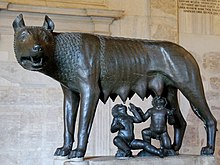
The wolf is a common motif in the mythologies and cosmologies of peoples throughout its historical range. The
In
In the
The concept of people turning into wolves, and the inverse, has been present in many cultures. One
In fable and literature
Aesop featured wolves in several of his fables, playing on the concerns of Ancient Greece's settled, sheep-herding world. His most famous is the fable of "The Boy Who Cried Wolf", which is directed at those who knowingly raise false alarms, and from which the idiomatic phrase "to cry wolf" is derived. Some of his other fables concentrate on maintaining the trust between shepherds and guard dogs in their vigilance against wolves, as well as anxieties over the close relationship between wolves and dogs. Although Aesop used wolves to warn, criticize and moralize about human behaviour, his portrayals added to the wolf's image as a deceitful and dangerous animal. The Bible uses an image of a wolf lying with a lamb in a utopian vision of the future. In the New Testament, Jesus is said to have used wolves as illustrations of the dangers his followers, whom he represents as sheep, would face should they follow him.[167]

Isengrim the wolf, a character first appearing in the 12th-century Latin poem
Wolves are among the central characters of Rudyard Kipling's The Jungle Book. His portrayal of wolves has been praised posthumously by wolf biologists for his depiction of them: rather than being villainous or gluttonous, as was common in wolf portrayals at the time of the book's publication, they are shown as living in amiable family groups and drawing on the experience of infirm but experienced elder pack members.[173] Farley Mowat's largely fictional 1963 memoir Never Cry Wolf is widely considered to be the most popular book on wolves, having been adapted into a Hollywood film and taught in several schools decades after its publication. Although credited with having changed popular perceptions on wolves by portraying them as loving, cooperative and noble, it has been criticized for its idealization of wolves and its factual inaccuracies.[174][175][176]
Conflicts
Human presence appears to stress wolves, as seen by increased cortisol levels in instances such as snowmobiling near their territory.[177]
Predation on livestock

Livestock depredation has been one of the primary reasons for hunting wolves and can pose a severe problem for wolf conservation. As well as causing economic losses, the threat of wolf predation causes great stress on livestock producers, and no foolproof solution of preventing such attacks short of exterminating wolves has been found.[178] Some nations help offset economic losses to wolves through compensation programs or state insurance.[179] Domesticated animals are easy prey for wolves, as they have been bred under constant human protection, and are thus unable to defend themselves very well.[180] Wolves typically resort to attacking livestock when wild prey is depleted.[181] In Eurasia, a large part of the diet of some wolf populations consists of livestock, while such incidents are rare in North America, where healthy populations of wild prey have been largely restored.[178]
The majority of losses occur during the summer grazing period, untended livestock in remote pastures being the most vulnerable to wolf predation.[182] The most frequently targeted livestock species are sheep (Europe), domestic reindeer (northern Scandinavia), goats (India), horses (Mongolia), cattle and turkeys (North America).[178] The number of animals killed in single attacks varies according to species: most attacks on cattle and horses result in one death, while turkeys, sheep and domestic reindeer may be killed in surplus.[183] Wolves mainly attack livestock when the animals are grazing, though they occasionally break into fenced enclosures.[184]
Competition with dogs
A review of the studies on the competitive effects of dogs on sympatric carnivores did not mention any research on competition between dogs and wolves.[185][186] Competition would favour the wolf, which is known to kill dogs; however, wolves usually live in pairs or in small packs in areas with high human persecution, giving them a disadvantage when facing large groups of dogs.[186][187]
Wolves kill dogs on occasion, and some wolf populations rely on dogs as an important food source. In Croatia, wolves kill more dogs than sheep, and wolves in Russia appear to limit stray dog populations. Wolves may display unusually bold behaviour when attacking dogs accompanied by people, sometimes ignoring nearby humans. Wolf attacks on dogs may occur both in house yards and in forests. Wolf attacks on hunting dogs are considered a major problem in Scandinavia and Wisconsin.[178][188] Although the number of dogs killed each year by wolves is relatively low, it induces a fear of wolves entering villages and farmyards to prey on them. In many cultures, dogs are seen as family members, or at least working team members, and losing one can lead to strong emotional responses such as demanding more liberal hunting regulations.[186]
Dogs that are employed to guard sheep help to mitigate human–wolf conflicts, and are often proposed as one of the non-lethal tools in the conservation of wolves.[186][189] Shepherd dogs are not particularly aggressive, but they can disrupt potential wolf predation by displaying what is to the wolf ambiguous behaviours, such as barking, social greeting, invitation to play or aggression. The historical use of shepherd dogs across Eurasia has been effective against wolf predation,[186][190] especially when confining sheep in the presence of several livestock guardian dogs.[186][191] Shepherd dogs are sometimes killed by wolves.[186]
Attacks on humans

The fear of wolves has been pervasive in many societies, though humans are not part of the wolf's natural prey.[192] How wolves react to humans depends largely on their prior experience with people: wolves lacking any negative experience of humans, or which are food-conditioned, may show little fear of people.[193] Although wolves may react aggressively when provoked, such attacks are mostly limited to quick bites on extremities, and the attacks are not pressed.[192]
Predatory attacks may be preceded by a long period of habituation, in which wolves gradually lose their fear of humans. The victims are repeatedly bitten on the head and face, and are then dragged off and consumed unless the wolves are driven off. Such attacks typically occur only locally and do not stop until the wolves involved are eliminated. Predatory attacks can occur at any time of the year, with a peak in the June–August period, when the chances of people entering forested areas (for livestock grazing or berry and mushroom picking) increase.[192] Cases of non-rabid wolf attacks in winter have been recorded in Belarus, Kirov and Irkutsk oblasts, Karelia and Ukraine. Also, wolves with pups experience greater food stresses during this period.[35] The majority of victims of predatory wolf attacks are children under the age of 18 and, in the rare cases where adults are killed, the victims are almost always women.[192] Indian wolves have a history of preying on children, a phenomenon called "child-lifting". They may be taken primarily in the spring and summer periods during the evening hours, and often within human settlements.[194]
Cases of rabid wolves are low when compared to other species, as wolves do not serve as primary reservoirs of the disease, but can be infected by animals such as dogs, jackals and foxes. Incidents of rabies in wolves are very rare in North America, though numerous in the eastern
Human hunting of wolves
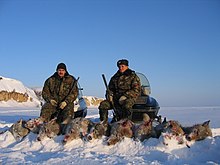
Theodore Roosevelt said wolves are difficult to hunt because of their elusiveness, sharp senses, high endurance, and ability to quickly incapacitate and kill hunting dogs.[196] Historic methods included killing of spring-born litters in their dens, coursing with dogs (usually combinations of sighthounds, Bloodhounds and Fox Terriers), poisoning with strychnine, and trapping.[197][198]
A popular method of wolf hunting in Russia involves trapping a pack within a small area by encircling it with fladry poles carrying a human scent. This method relies heavily on the wolf's fear of human scents, though it can lose its effectiveness when wolves become accustomed to the odor. Some hunters can lure wolves by imitating their calls. In Kazakhstan and Mongolia, wolves are traditionally hunted using eagles and large falcons, though this practice is declining, as experienced falconers are becoming few in number. Shooting wolves from aircraft is highly effective, due to increased visibility and direct lines of fire.[198] Several types of dog, including the Borzoi and Kyrgyz Tajgan, have been specifically bred for wolf hunting.[186]
As pets and working animals
Wolves and
Notes
- ^ Populations of Bhutan, India, Nepal, and Pakistan are included in Appendix I. Excludes domesticated form and dingo, which are referenced as Canus lupus familiaris and Canus lupus dingo.
- phylogeneticbut not colloquial definition of 'wolf', and thus not in the scope of this article.
References
- S2CID 83594819.
- ^ . Retrieved November 19, 2021.
- ^ "Appendices | CITES". cites.org. Retrieved January 14, 2022.
- ^ a b c Linnæus, Carl (1758). "Canis Lupus". Systema naturæ per regna tria naturæ, secundum classes, ordines, genera, species, cum characteribus, differentiis, synonymis, locis. Tomus I (in Latin) (10 ed.). Holmiæ (Stockholm): Laurentius Salvius. pp. 39–40.
- ^ Harper, Douglas. "wolf". Online Etymology Dictionary.
- ^ A. Lehrman (1987). "Anatolian Cognates of the PIE Word for 'Wolf'". Die Sprache. 33: 13–18.
- ^ Young, Stanley P.; Goldman, Edward A. (1944). The Wolves of North America, Part I. New York, Dover Publications, Inc. p. 390.
- ^ Marvin 2012, pp. 74–75.
- PMID 26234211.
- ^ Harper, Douglas. "canine". Online Etymology Dictionary.
- ISBN 0521415292.
- OCLC 62265494.
- PMID 24453989.
- ^ Alvares, Francisco; Bogdanowicz, Wieslaw; Campbell, Liz A.D.; Godinho, Rachel; Hatlauf, Jennifer; Jhala, Yadvendradev V.; Kitchener, Andrew C.; Koepfli, Klaus-Peter; Krofel, Miha; Moehlman, Patricia D.; Senn, Helen; Sillero-Zubiri, Claudio; Viranta, Suvi; Werhahn, Geraldine (2019). "Old World Canis spp. with taxonomic ambiguity: Workshop conclusions and recommendations. CIBIO. Vairão, Portugal, 28–30 May 2019" (PDF). IUCN/SSC Canid Specialist Group. Retrieved March 6, 2020.
- ^ Mech & Boitani 2003, pp. 239–245.
- ^ ISBN 978-3-030-04752-8.
- ^ PMID 24453982.
- PMID 26004765.
- ^ PMID 26680994.
- S2CID 237147842.
- hdl:10651/50748.
- S2CID 88740690.
- S2CID 26721918.
- ^ PMID 30344120.
- ^ PMID 30419012.
- PMID 31563851.
- .
- ^ PMID 24622972.
- .
- S2CID 225956269.
- ^ from the original on July 31, 2019. Retrieved July 30, 2019.
- ^ Heptner & Naumov 1998, pp. 129–132.
- ^ a b Heptner & Naumov 1998, p. 166.
- ^ Mech 1981, p. 13.
- ^ a b c d e f g h i j k l m n o p q Heptner & Naumov 1998, pp. 164–270.
- ^ Mech 1981, p. 14.
- .
- ^ Mech & Boitani 2003, p. 112.
- ^ ]
- ^ a b Lopez 1978, p. 23.
- ^ a b Heptner & Naumov 1998, p. 174.
- ^ ISBN 978-0-19-104572-1.
- ISBN 978-0-7607-1969-5.
- ^ a b c Lopez 1978, p. 19.
- ^ Lopez 1978, p. 18.
- ^ Lopez 1978, pp. 19–20.
- ^ JSTOR 3784236.
- ^ Heptner & Naumov 1998, pp. 168–169.
- ^ Heptner & Naumov 1998, p. 168.
- ^ Lopez 1978, p. 22.
- PMID 19197024.
- S2CID 5228987.
- S2CID 85236511.
- .
- ISBN 978-1-4102-0249-9.
- ^ S2CID 31174275.
- ^ a b Mech & Boitani 2003, p. 107.
- ^ Mech & Boitani 2003, pp. 109–110.
- ^ Mech 1981, p. 172.
- ^ a b Mech & Boitani 2003, p. 201.
- ^ a b c d Heptner & Naumov 1998, pp. 213–231.
- S2CID 91073874.
- ^ Woodford, Riley (November 2004). "Alaska's Salmon-Eating Wolves". Wildlifenews.alaska.gov. Retrieved July 25, 2019.
- ISBN 978-0520254732.
- ISBN 978-0785837381.
- ^ Mech & Boitani 2003, p. 109.
- ^ Mech 1981, p. 180.
- ^ Klein, D. R. (1995). "The introduction, increase, and demise of wolves on Coronation Island, Alaska". In Carbyn, L. N.; Fritts, S. H.; Seip, D. R. (eds.). Ecology and conservation of wolves in a changing world. Canadian Circumpolar Institute, Occasional Publication No. 35. pp. 275–280.
- ^ a b Mech & Boitani 2003, pp. 266–268.
- ^ Merrit, Dixon (January 7, 1921). "World's Greatest Animal Dead" (PDF). US Department of Agriculture Division of Publications. p. 2. Archived (PDF) from the original on July 24, 2019. Retrieved July 26, 2019.
- ^ Giannatos, G. (April 2004). "Conservation Action Plan for the golden jackal Canis aureus L. in Greece" (PDF). World Wildlife Fund Greece. pp. 1–47. Archived (PDF) from the original on December 9, 2017. Retrieved October 29, 2019.
- ^ Mech & Boitani 2003, p. 269.
- ^ Mech & Boitani 2003, pp. 261–263.
- ^ Mech & Boitani 2003, pp. 263–264.
- ^ Mech & Boitani 2003, p. 266.
- ^ a b Mech & Boitani 2003, p. 265.
- ISBN 0-226-77999-8.
- ^ Mech & Boitani 2003, pp. 264–265.
- .
- PMID 31966128.
- ISBN 1-55963-080-9. Archivedfrom the original on June 3, 2016. Retrieved November 22, 2015.
- ^ Monchot, H.; Mashkour, H. (2010). "Hyenas around the cities. The case of Kaftarkhoun (Kashan- Iran)". Journal of Taphonomy. 8 (1): 17–32..
- ISBN 978-2-8317-0442-5. Archivedfrom the original on May 16, 2016. Retrieved November 22, 2015.
- ^ Nayak, S.; Shah, S.; Borah, J. (2015). "Going for the kill: an observation of wolf-hyaena interaction in Kailadevi Wildlife Sanctuary, Rajasthan, India". Canid Biology & Conservation. 18 (7): 27–29.
- S2CID 85957777.
- ^ Mech & Boitani 2003, pp. 208–211.
- ^ a b Mech & Boitani 2003, pp. 211–213.
- ^ Graves 2007, pp. 77–85.
- ^ a b Mech & Boitani 2003, pp. 202–208.
- ^ Mech & Boitani 2003, p. 164.
- ^ a b Mech & Boitani 2003, pp. 2–3, 28.
- PMID 26398784.
- ^ Mech & Boitani 2003, pp. 1–2.
- ^ Mech & Boitani 2003, pp. 12–13.
- ISBN 9780801825255.
- ^ Mech & Boitani 2003, p. 38.
- ^ S2CID 62800394.
- ^ a b c Mech & Boitani 2003, pp. 19–26.
- from the original on July 24, 2018. Retrieved January 10, 2019.
- ISBN 0-8166-2959-5.
- ^ Mech & Boitani 2003, pp. 66–103.
- ^ Busch 2007, p. 59.
- ^ Lopez 1978, p. 38.
- ^ Lopez 1978, pp. 39–41.
- ^ Mech & Boitani 2003, p. 90.
- PMID 1200478.
- ^ a b c Heptner & Naumov 1998, p. 248.
- ^ Mech & Boitani 2003, p. 5.
- ^ Mech & Boitani 2003, p. 175.
- ^ Heptner & Naumov 1998, pp. 234–238.
- ^ a b Mech & Boitani 2003, pp. 42–46.
- ^ a b Heptner & Naumov 1998, pp. 249–254.
- ^ Mech & Boitani 2003, p. 47.
- ^ Mech & Boitani 2003, pp. 46–49.
- ISBN 978-0894642029.
- ^ Mech & Boitani 2003, pp. 119–121.
- S2CID 52063038.
- ^ Mech, Smith & MacNulty 2015, p. 4.
- ^ Heptner & Naumov 1998, p. 233.
- ^ Heptner & Naumov 1998, p. 240.
- .
- ^ a b Mech, Smith & MacNulty 2015, pp. 1–3.
- ^ Mech, Smith & MacNulty 2015, p. 7.
- ^ Mech, Smith & MacNulty 2015, p. 82–89.
- ISBN 978-0-285-62411-5.
- ^ Mech 1981, p. 185.
- ^ Mech & Boitani 2003, p. 58.
- ^ Mech & Boitani 2003, pp. 122–125.
- ^ Mech & Boitani 2003, p. 230.
- ^ a b Mech & Boitani 2003, pp. 321–324.
- ^ Government of Canada (July 29, 2019). "Schedule 3 (section 26) Protected Species". Justice Laws Website. Archived from the original on April 9, 2019. Retrieved October 30, 2019.
- ^ State of Alaska (October 29, 2019). "Wolf Hunting in Alaska". Alaska Department of Fish and Game. Archived from the original on September 30, 2019. Retrieved October 30, 2019.
- ^ "Wolf Recovery under the Endangered Species Act" (PDF). US Fish and Wildlife Service. February 2007. Archived (PDF) from the original on August 3, 2019. Retrieved September 1, 2019.
- ^ "Wolf Numbers in Minnesota, Wisconsin and Michigan (excluding Isle Royale)—1976 to 2015". U.S. Fish and Wildlife Service. Retrieved March 23, 2020.
- ^ "How many wild wolves are in the United States?". Wolf Conservation Center. Retrieved May 10, 2023.
- ISBN 0816639787.
- ^ "Mexican Wolf Population Grows for Eighth Consecutive Year | U.S. Fish & Wildlife Service". www.fws.gov. March 5, 2024. Retrieved March 6, 2024.
- ^ a b "Status of large carnivore populations in Europe 2012–2016". European Commission. Archived from the original on September 2, 2019. Retrieved September 2, 2019.
- ^ European Commission: Status, management and distribution of large carnivores—bear, lynx, wolf & wolverine—in Europe December 2012. page 50.
- ^ Mech & Boitani 2003, pp. 318–320.
- ^ The Wolf Dilemma: Following the Practices of Several Actors in Swedish Large Carnivore Management. Ramsey, Morag (2015) https://www.diva-portal.org/smash/get/diva2:821120/FULLTEXT01.pdf Retrieved 30 September 2023
- .
- .
- ^ "The Wolf in Russia—situations and problems" (PDF). Wolves and Humans Foundation. Archived from the original (PDF) on September 23, 2007. Retrieved September 2, 2019.
- ^ a b Fisher, A. (January 29, 2019). "Conservation in conflict: Advancement and the Arabian wolf". Middle East Eye. Archived from the original on November 7, 2019. Retrieved November 11, 2019.
- ^ Mech & Boitani 2003, pp. 323, 327.
- ^ Busch 2007, p. 231.
- ^ Şekercioğlu, Çağan (December 15, 2013). "Turkey's Wolves Are Texting Their Travels to Scientists". National Geographic. Archived from the original on October 6, 2019. Retrieved November 19, 2019.
- ^ Mech & Boitani 2003, p. 327.
- JSTOR 2386069.
- PMID 30969994.
- ^ Mech & Boitani 2003, p. 328.
- PMID 28585433.
- ^ Busch 2007, p. 232.
- PMID 26082870.
- S2CID 27005517.
- ^ a b Mech & Boitani 2003, p. 292.
- ^ Lopez 1978, p. 210.
- ^ Marvin 2012, p. 128.
- ^ ISBN 978-0826419132.
- ^ Marvin 2012, p. 78.
- ^ Lopez 1978, p. 133.
- ^ Busch 2007, p. 110.
- ^ Marvin 2012, p. 47.
- ^ Marvin 2012, p. 50.
- ^ Lopez 1978, p. 123.
- ^ Marvin 2012, pp. 38–45.
- ^ Lopez 1978, p. 259.
- ^ Marvin 2012, pp. 64–70.
- ^ Lopez 1978, p. 263.
- ^ Graves 2007, pp. 21, 123.
- ^ Marvin 2012, p. 162.
- ^ Cassidy, K; Smith, D. W.; Mech, L. D.; MacNulty, D. R.; Stahler, D. R.; Metz, M. C. (2006). "Territoriality and interpack aggression in wolves: Shaping a social carnivore's life history. Rudyard Kipling's Law of the Jungle Meets Yellowstone's Law of the Mountains". Yellowstone Science. 24 (1): 37–41.
- ^ Mech & Boitani 2003, p. 294.
- ^ Jones, K. (2001). "Never Cry Wolf: Science, Sentiment, and the Literary Rehabilitation of Canis Lupus". The Canadian Historical Review. 84. Archived from the original on October 12, 2013. Retrieved July 28, 2012.
- ^ Grooms, Steve (2008). "The Mixed Legacy of Never Cry Wolf" (PDF). International Wolf. 18 (3): 11–13. Archived from the original (PDF) on June 21, 2010.
- S2CID 84878446.
- ^ a b c d Mech & Boitani 2003, p. 305.
- ^ Mech & Boitani 2003, p. 309.
- ^ Mech 1981, p. 173.
- ^ Levy, Max G. (December 11, 2020). "These Non-Lethal Methods Encouraged by Science Can Keep Wolves From Killing Livestock". Smithsonian Magazine. Retrieved December 16, 2020.
- ^ Mech & Boitani 2003, p. 307.
- ^ Mech & Boitani 2003, p. 306.
- ^ Graves 2007, p. 45.
- ISBN 978-0199663217.
- ^ .
- ^ Boitani, L. (1983). "Wolf and dog competition in Italy". Acta Zoologica Fennica (174): 259–264.
- ^ Backeryd, J. (2007). "Wolf attacks on dogs in Scandinavia 1995–2005—Will wolves in Scandinavia go extinct if dog owners are allowed to kill a wolf attacking a dog?" (PDF). Examensarbete, Institutionen för ekologi, Grimsö forskningsstation. Sveriges Lantbruksuniversitet. Archived from the original (PDF) on July 17, 2019. Retrieved July 17, 2019.
- .
- ISBN 9780521425377.
- S2CID 86058778.
- ^ ISBN 978-82-426-1292-2. Archived(PDF) from the original on May 17, 2014. Retrieved August 16, 2013.
- ^ Mech & Boitani 2003, pp. 300–304.
- ^ Rajpurohit, K.S. (1999). "Child lifting: Wolves in Hazaribagh, India". Ambio. 28: 162–166.
- ^ Heptner & Naumov 1998, p. 267.
- ^ Roosevelt, Theodore (1909). Hunting the grisly and other sketches; an account of the big game of the United States and its chase with horse, hound, and rifle. G. P. Putnam's sons. pp. 179–207. Archived from the original on June 24, 2015. Retrieved May 14, 2014.
- ^ Lopez 1978, p. 108.
- ^ a b Graves 2007, pp. 121–140.
- ^ Tucker, P.; Weide, B. (1998). "Can You Turn a Wolf into a Dog" (PDF). Wild Sentry. Archived from the original (PDF) on December 8, 2015. Retrieved March 21, 2016.
Bibliography
- Busch, R. H. (2007). Wolf Almanac, New and Revised: A Celebration Of Wolves And Their World (3 ed.). ISBN 978-1-59921-069-8.
- Graves, Will (2007). Wolves in Russia: Anxiety throughout the ages. Detselig Enterprises. ISBN 978-1-55059-332-7.
- Heptner, V. G.; Naumov, N. P. (1998). Mammals of the Soviet Union Vol. II Part 1a, Sirenia and Carnivora (Sea cows; Wolves and Bears). Science Publishers, Inc. USA. ISBN 978-1-886106-81-9.
- Lopez, Barry H. (1978). Of Wolves and Men. J. M. Dent and Sons Limited. ISBN 978-0-7432-4936-2.
- Marvin, Garry (2012). Wolf. ISBN 978-1-86189-879-1.
- Mech, L. David (1981). The Wolf: The Ecology and Behaviour of an Endangered Species. ISBN 978-0-8166-1026-6.
- Mech, L. David; Boitani, Luigi, eds. (2003). Wolves: Behaviour, Ecology and Conservation. ISBN 978-0-226-51696-7.
- Mech, L. David; Smith, Douglas W.; MacNulty, Daniel R. (2015). Wolves on the Hunt: The Behavior of Wolves Hunting Wild Prey. ISBN 978-0-226-25514-9.
External links
- The International Wolf Center
- Staying Safe in Wolf Country, ADFG (January 2009)
- Watch Death of a Legend and Cry of the Wild by Bill Mason


